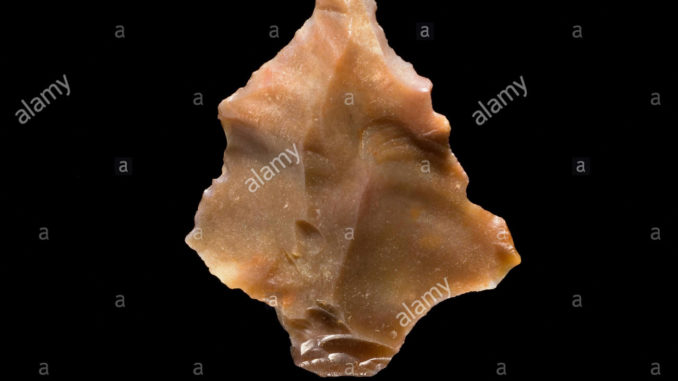
The “Aterian” stone tool style or industry from North Africa is named for the first or “type” site where these distinctive hunting weapons and food processing tools were described: Bir el-Atir in Algeria.
The “Aterian” stone tool technology and cultural group was originally thought to date to the period from 40,000 to 20,000 years before the present. However, more recent scientific technologies have been used to re-examine the stone tools and have pushed back the time horizon for this technology of stone tool making to a much older range: from 85,000 to 40,000 years of age.
The manufacturing process for these tools is derived from the earlier “Mousterian” methods for working stone, using prepared and shaped cores from which were struck off large flakes which were then often unifacially trimmed into the desired tool shapes.
This older stone working process was long used by archaic types of humans, such as Neanderthals and Heidelbergensis. However, all of the human remains associated with “Aterian” tools and sites have been “early modern” humans.
They continued with the same basic stone working processes, but with a major conceptual difference. The “Aterian” style tools are the first to have clearly been designed and manufactured to be mounted on handles, with the projectile points and the scrapers having distinctive prepared “tangs” at the base of the tool or projectile point.
A “tang” serves as a protruding structure which enables a tool or blade to be inserted into a split handle or shaft material, like wood or bone, and then bound in position with cord of some sort, or with a binding agent like a glue which will harden to form a permanent bond. Another term for tang is “haft”.
The “Aterian” culture ranged all across North Africa, from Morocco in the west and as far east as the Kharga Oasis in Egypt. The Kharga Oasis is located in the desert lands a good distance west of the Nile River Valley.
Here is a description of the size and characteristics of three typical “Aterian” implements from North Africa. Among these three pieces is an “Aterian” unifacial projectile point, from the Middle Paleolithic (Middle Sone Age), which measures 1-5/8″ long by 1-1/8″ wide. The knapping work was performed on one face of the stone, with the underside essentially untouched. This is why it is termed unifacial. The projectile point is roughly triangular in shape, with the tang for mounting to a shaft protruding from the base of the triangle.
The two unifacial, tanged scraping and processing tools feature rounded working edges, at the end opposite the tang used for mounting the tools to handles. These are about 2-1/2″ long and 2″ across the rounded working edge of the tool. The shape of these two is more of an oval, with the tang protruding from one of the longer sides of the oval. This tang would be attached to a wooden or bone handle to provide greater force and control at the processing edge of the scraper or processing tool.
These implements date from a time 85,000 to 40,000 years before present, when the Sahara Desert region was rich in grasslands, teeming with wild herds, and populated by a widespread early modern hunter-gatherer population.
Even though they were early modern humans, the “Aterians” were still using tool manufacturing processes which were long utilized by archaic human populations such as the Neanderthal culture in North Africa and Europe. These were the earliest tanged tools and weapons, made specifically to be attached to handles and shafts.
Copyright 2009, all rights reserved. F. Scott Crawford, Carrollton, Texas, USA.
Proudly WWW.PONIREVO.COM



